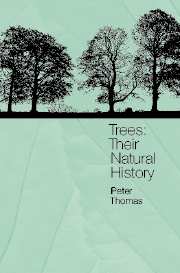Book contents
- Frontmatter
- Contents
- Preface
- 1 An overview
- 2 Leaves: the food producers
- 3 Trunk and branches: more than a connecting drainpipe
- 4 Roots: the hidden tree
- 5 Towards the next generation: flowers, fruits and seeds
- 6 The growing tree
- 7 The shape of trees
- 8 The next generation: new trees from old
- 9 Health, damage and death: living in a hostile world
- Further reading
- Index
Preface
Published online by Cambridge University Press: 05 September 2012
- Frontmatter
- Contents
- Preface
- 1 An overview
- 2 Leaves: the food producers
- 3 Trunk and branches: more than a connecting drainpipe
- 4 Roots: the hidden tree
- 5 Towards the next generation: flowers, fruits and seeds
- 6 The growing tree
- 7 The shape of trees
- 8 The next generation: new trees from old
- 9 Health, damage and death: living in a hostile world
- Further reading
- Index
Summary
Why write a book on trees? The motivation for me came from the frustration of trying to teach a subject where much is known but is scattered over a huge range of journals and books from many countries. There are so many fascinating stories to be told about the ways in which trees cope with the world and the problems of being large and long-lived: they are extremely well designed. Someone had to write this book!
My goal was to draw together strands of information to create a readable book that would answer common questions about trees, set right a number of myths and open up the remarkable world of how trees work, grow, reproduce and die. It is for you, the reader, to judge whether I have been successful. Please let me know where you find errors or would wish to argue with the logic.
I am indebted to all those who helped with this book, especially Roger Davidson and Bill Williams who read and commented on the whole manuscript and numerous colleagues who commented on parts. Val Brown, P.B. Tomlinson, Colin Black and K.J. Niklas kindly provided detailed information. Maria Murphy and Lynn Davy at Cambridge University Press are to be congratulated for their extreme patience with a faltering author. And, of course, my wife and sons are thanked for putting up with my pet project.
- Type
- Chapter
- Information
- TreesTheir Natural History, pp. ix - xPublisher: Cambridge University PressPrint publication year: 2000



